Current US defense strategy recognizes that success or failure in future theater conflicts will hinge largely on the outcome of the opening phase of the campaign–what has come to be called the “halt” phase. The Report of the Quadrennial Defense Review notes that maintaining the capability “to rapidly defeat initial enemy advances short of their objectives … is absolutely critical to the United States’ ability to seize the initiative … and to minimize the amount of territory we and our allies must regain.”
In theater conflicts, if the US and allies can halt the attacking force short of its primary objectives, the remainder of the conflict is likely to unfold along favorable lines. Having halted the attack, the allied coalition will have gone far toward seizing the initiative from the enemy. Coalition forces should also find it easier to secure important rear-area assets needed to facilitate arrival of follow-on reinforcements and supplies. By halting the attack short of its primary objectives, the United States and its allies will have denied the enemy its most important bargaining asset. Failing to do so would mean war of incalculably greater risk.
We investigated the potential of new concepts for destroying and halting moving armored forces. These new joint concepts incorporate advanced munitions with systems for theaterwide surveillance and control. Such an approach would allow rapidly deployable, longer-range firepower systems–such as aircraft and air- and surface-launched missiles–to locate, identify, engage, and destroy enemy forces far more quickly and effectively than ever before. The centerpiece of our analysis is a novel and fairly transparent quantitative approach that estimates the ability of US forces to damage and halt an invading mechanized ground force. We designed a generic scenario involving forces that a reasonably competent and fairly well-equipped regional adversary, such as Iran or Iraq, might bring to bear roughly 10 years from now. In this scenario, enemy forces attempt to seize key territory. Enemy forces include several army corps, 500 attack and interceptor aircraft, chemical and biological weapons, ballistic and cruise missiles, and reasonably modern surface-to-air defenses.
Our conclusion: Modern, longer-range firepower systems-coupled with new surveillance and control capabilities and equipped with advanced anti-armor munitions-can engage and heavily damage large numbers of moving mechanized forces. In theaters that do not feature heavily foliated or urbanized terrain, joint US forces will be able to rapidly halt armored invasions short of their objectives even in highly stressing scenarios–provided sufficient investments are made in the emerging information and firepower systems.
The Base-Case Scenario
For the base case, we assume a US posture somewhat more robust than that deployed today in the Gulf. Forces consist of five squadrons of land-based aircraft, pre-positioned equipment for two heavy Army brigades, a battalion of 24 AH-64 Apache helicopters, a carrier battle group with aircraft and Tomahawk missiles, and 250 Army Tactical Missile System (ATACMS) missiles, mounted either on multiple launch rocket system launchers or, as has been proposed, Navy surface combatants afloat in the region. Modest numbers of surveillance and control assets-notably E-3 AWACS, E-8 Joint STARS, RC-135 Rivet Joint, E-2 Hawkeye, and P-3 Orion aircraft-provide the eyes and ears of these forward deployed forces. We also assume in this base case that all air-to-ground munitions are pre-positioned at multiple locations and can be distributed to main operating bases by intratheater airlift and surface transportation.
We assume that the enemy’s chief objective is to seize critical assets some distance from the prewar border. Mechanized ground forces spearheading the enemy advance are instructed to move as rapidly as possible. We assume that the leading edge of those forces moves at an average rate of approximately 70 kilometers per day. We assume as well that each unit moving forward will sustain this average velocity until that unit suffers the loss of some 70 percent of its armored vehicles. This assumption is based on a deliberately conservative judgment of the level of attrition required to render an attacking force incapable of coherent offensive operations. We also assume that the enemy uses its air defenses to try to protect this advancing force. That is, mobile Surface-to-Air Missiles advance along with the leading edge of the attacking ground force, and interceptors operate from time to time within this same airspace.
Our base case assumes that the enemy possesses but does not use lethal chemical, biological, or nuclear weapons in the halt phase–not because such use can be ruled out but rather because we believe that most adversaries would prefer to achieve their objectives without running the risks associated with first use of such weapons. In this case, we assume that the enemy reserves Weapons of Mass Destruction as a means for helping to ensure the survival of his regime should the war turn bad. Our assessment of the effects of WMD use is summarized below.
First Enable, Then Destroy
To deploy forces of sufficient size into the theater with acceptable risk and employ that force effectively, US and allied forces must gain a measure of control over other enemy military capabilities. Therefore to defeat an enemy attack, we first focus on gaining a foothold in the theater and creating favorable conditions under which friendly forces can operate. This is the “enabling” portion of the halt phase. We then focus on destroying enemy armored columns as rapidly as possible. Key objectives:
- Protect rear-area airfields, ports, and the like.
- Suppress and destroy enemy air defenses.
- Disrupt enemy C3 and transportation networks.
- Destroy Weapons of Mass Destruction when found.
Assets to accomplish these objectives would be those in theater prior to the outbreak of hostilities, as well as those that could arrive within the first few days after C-day (the day that large-scale US reinforcement begins). Notable among these are: F-15Cs, F-22s, and multirole aircraft for air defense and sweeps against enemy aircraft; the Airborne Laser system, Aegis upper tier, and Patriot or other land-based ballistic missile defense systems; B-2 bombers to destroy the most capable enemy SAM systems; and F-18 and F-16 fighters carrying High-speed Anti-Radiation Missiles to suppress other SAM radars. Also needed are systems for precision attacks on fixed, hardened targets. Examples are stealthy F-117 attack aircraft, Tomahawk land attack missiles, joint air to surface standoff missiles, and conventional air launched cruise missiles.
Not until the enabling phase has been under way for some time-in our assessment, four to five days-would the bulk of the assets be turned to attacks on the enemy’s armored columns. Given a relatively modern and reasonably well-employed enemy air defense system, it would take about this long before nonstealthy aircraft, such as the B-1B and the F-15E, could operate at medium altitudes with relative safety. Once the enemy’s interceptor and SAM forces had been suppressed, however, these and other platforms can bring massive firepower to bear.
| Fig. 1 Assumed Deployment: Base Case, Halt Phase | |
| Day 0
(in place) |
Forces (fighter aircraft in squadrons)
2 units F-15C, F-16(L), A-10, F-16HTS; 3 units FA-18; 1 unit AH-64; 250 ATACMS |
| 1 | F-22, F-117, 8 B-2 |
| 2 | F-22, 3 units Airborne Laser |
| 3 | F-16HTS, F-15C |
| 4 | F-15E |
| 5 | F-15E, 50 B-1B |
| 6 | F-16(L) |
| 7 | F-16(L), F-15C; 3 units F/A-18 (USN); 2 units F/A-18 (USMC) |
| 8 | F-15E |
| 9 | F-16(L) |
| 10 | 2 units F-16 |
| 11 | O/A-10 |
| 12 | O/A-10 |
| F-16(L) refers to F-16s equipped with LANTIRN; F-16HTS refers to F-16s equipped with HARM Targeting System, used for SEAD. | |
Fig. 1 shows the flow of US firepower assets to the theater over the first 12 days of the war. This arrival rate assumes that Civil Reserve Air Fleet Stage II has been activated and that, by Day 4, 900 tons of intertheater airlift capacity are available to support USAF deployments each day. The table shows the Air Force could expect to deploy approximately 1.5 squadrons of combat aircraft a day to a distant theater under such conditions. We also show 50 B-1Bs arriving on Day 5 and a second carrier, along with two squadrons of Marine Corps F-18s, arriving on Day 7. Also deploying are additional support aircraft, including those for reconnaissance (U-2s, RC-135s, E-2s, and P-3s), surveillance and control (E-3s and E-8s), aerial refueling (KC-135s and KC-10s), search and rescue, and intratheater airlift.
 Fig. 2 provides two snapshots characterizing allocation of available firepower assets on Day 4 and Day 8 of the halt phase. On Day 4, the bulk of the effort is devoted to such enabling tasks as Suppression of Enemy Air Defenses, air defense and sweep missions (air-to-air), and attacks on high-value and time-sensitive fixed targets. By Day 8, more assets are available to the commander, and most of them are devoted to attacking the enemy’s advancing armored columns.
Fig. 2 provides two snapshots characterizing allocation of available firepower assets on Day 4 and Day 8 of the halt phase. On Day 4, the bulk of the effort is devoted to such enabling tasks as Suppression of Enemy Air Defenses, air defense and sweep missions (air-to-air), and attacks on high-value and time-sensitive fixed targets. By Day 8, more assets are available to the commander, and most of them are devoted to attacking the enemy’s advancing armored columns.
Operational Objectives
In this scenario, the mechanized, enemy ground force is confined to a discrete number of main axes of advance. We assume in our base case that lead elements of enemy forces rapidly move along each axis unless they encounter significant resistance in the form of either an opposing ground force or heavy and effective firepower. As longer-range air and surface systems attack each element of the advancing force to a specified high level of damage, we assume that those units are pulled out of the line of march for the remainder of the halt phase. The net advance of the leading edge of the unattacked units on any given day is then the difference between the “base rate” (in this case, 70 km) and the column length (in kilometers) that can be attacked with sufficient lethality to achieve the damage level necessary to render the attacking units ineffective.
The number of kilometers’ worth of armored columns attacked each day is determined by factors contributing to the amount and effectiveness of longer-range anti-armor firepower: the number of assets available, their sortie rate, their payload and weapon characteristics, the portion of attack assets that actually find valid targets (determined by the surveillance, assessment, and battle management assets available), and the level of damage that is deemed necessary to compel an enemy unit to halt.
Values are assumed for every variable for each day of the halt phase. We assumed, for example, in our base case run that the 50 B-1B aircraft in theater had a sortie rate of 0.75. Hence, the aircraft were assumed to fly a total of 37 sorties per day, all of which were allocated to attacking moving armored columns. Of these sorties, 25 are assumed to have attacked their intended targets. Those sorties delivered a total of 750 Wind-Corrected Munitions Dispenserupgraded Sensor Fuzed Weapons, each filled with 40 Skeet-smart target- sensing weapons. In a similar way, the other firepower assets-fixed-wing fighterbombers, attack helicopters, and ATACMS missiles-are allocated to destroy moving armor.
We assume that by the middle part of the next decade-the time frame of this study-assets such as JSTARS, UAVs, and other sensor platforms will provide sufficient data to assessment centers to allow them to locate columns of moving vehicles, a high portion of them armored, even when columns are interspersed among a host of unarmored vehicles. Specifically, we assume that during the halt phase, when large numbers of armored vehicles are moving, about one-third of the sorties allocated to the attack of moving armor fail to find and engage columns rich in armored vehicles. We believe this assumption is conservative.
We also assume that all US attacks on moving armor entail use of a quality anti-armor munition: Most USAF aircraft deliver the WCMD/SFW, Navy and Marine aircraft deliver Joint Standoff Weapons with SFW, attack helicopters deliver Hellfire missiles, and ATACMS missiles deliver Brilliant Anti-Tank submunitions.
Weapons and Sortie Effectiveness
For area weapons, munitions effectiveness devolves to estimating the number of weapons that must be delivered against a column of vehicles to achieve a desired level of damage. Once the average spacing between armored vehicles is specified, damage expectancy can be translated into the average number of armored vehicles damaged or destroyed per weapon expended and per sortie.
Our focus is on the CBU-97 SFW, which incorporates the Skeet, now in production for USAF. When the dispenser released from an aircraft reaches appropriate altitude, it opens and releases 10 BLU-108 submunitions. These are slowed by parachutes, and as they approach ground level, a small rocket motor fires at the base of each munition, raising it up and spinning it. Each of the BLU-108s then tosses four Skeets along predetermined patterns. Collectively, these 40 Skeets cover an area roughly 400 meters by 200 meters. Each Skeet seeks out infrared signatures characteristic of vehicles with warm engines and, if it finds one, fires an explosively forged projectile that is able to penetrate several inches of armor plate.
In more than 100 tests of CBU-97s, each weapon, or dispenser, delivered against a representative column of armored vehicles and trucks, has damaged, on average, three to four armored vehicles. Average spacing between the armored vehicles in these columns has been around 50 meters. Thus, for the eight armored vehicles that fall within a single weapon’s 400-meter “footprint,” we can expect that nearly half of them will be damaged to at least an “availability kill” (or “A-kill”) level. This means that some component of the vehicle has been damaged to the extent that the vehicle must be withdrawn from the line of march and repaired before continuing on.
We next estimate the effect when multiple weapons are delivered against a column. We know we must expect diminishing returns to scale as bomblets are delivered with increasing density. Again, a range of outcomes is possible. At one end of the spectrum, the weapons could be delivered with optimal spacing, such that each pattern just overlapped its neighbors, providing “double” coverage over the entire segment of road attacked. We refer to this approach as “ordered fire.” For a situation in which each pattern measured 270 meters in length (the useful length of the pattern, assuming some delivery errors), it would take seven weapons to cover 1 km of road in this fashion. This density of Skeets would damage more than 70 percent of the armored vehicles within the weapon’s footprint. We judge that this level of damage would be sufficient to render a unit at least temporarily incapable of continued effective operations-that is, the unit can be considered to have halted for the time being.
At the other end of the spectrum, the weapons could be delivered randomly within the segment of the column attacked. We refer to this as “unordered fire.” Here, some sections of the column are triple covered or more, while others are totally uncovered. In this case, 10 weapons would be required per kilometer to achieve the same damage expectancy (greater than 70 percent) as the seven optimally laid down weapons. Guided dispensers, such as WCMD and JSOW, should allow a result closer to optimal. To be confident that we are not overstating the effectiveness of future anti-armor capabilities, we assume less-efficient random deliveries. Hence, in most of the cases that follow, we allot 10 WCMDs or 10 JSOWs for each kilometer segment of an armored column attacked.
What is the net effect of these assumptions on sortie effectiveness? A single F-16 can carry four CBU-97 weapons. If those weapons were each as effective as the single weapons delivered in tests, we would expect that each F-16 sortie would be able to engage around 30 armored vehicles and that it would damage approximately half of these. Note that this estimate is extrapolated from tests in which the armored vehicles were separated by an average of 50 meters. Intervehicular spacing of as much as 50 meters would be characteristic of a highly disciplined force, particularly once heavy attacks began. Nevertheless, we degrade that level of effectiveness first by assuming that the enemy can maintain, on average, 100 meters between each armored vehicle on the march. This assumption allows us to account for the possibility that some coalition anti-armor sorties will encounter armored formations with spacing considerably greater than 100 meters. We next assume the delivery errors mentioned above. We also account for the diminishing returns to scale and operational degrades stated earlier.
The net effect of these assumptions is to reduce our estimate of expected armored vehicle kills for a typical sortie by almost 90 percent from levels demonstrated in tests. This seems prudent, if not pessimistic.
Results of the Base Case
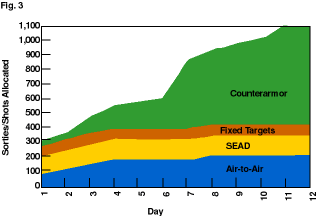 Fig. 3 shows the number of fixed- and rotary-wing sorties available in the first 12 days of the baseline scenario. (ATACMS shots are included and counted as one sortie each.) One can clearly see the shift in emphasis from “enabling” over the first five days to direct attacks against armor. The key is degrading the enemy’s airborne and surface-based air defenses to the point that nonstealthy aircraft, such as the B-1B and F-15E and other fighter-bombers, can operate with relatively low risk at medium altitudes.
Fig. 3 shows the number of fixed- and rotary-wing sorties available in the first 12 days of the baseline scenario. (ATACMS shots are included and counted as one sortie each.) One can clearly see the shift in emphasis from “enabling” over the first five days to direct attacks against armor. The key is degrading the enemy’s airborne and surface-based air defenses to the point that nonstealthy aircraft, such as the B-1B and F-15E and other fighter-bombers, can operate with relatively low risk at medium altitudes.
Fig. 4 tracks the enemy’s ability to press the attack in the face of the counterarmor capacity of US longer-range firepower assets, assuming that all 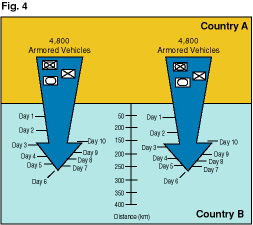 of the counterarmor assets deliver a quality munition. At first, while US forces are few in number and preoccupied with enabling efforts, enemy forces make good progress. By Day 6, however, US firepower has been able to reach and, by Day 7, to exceed the capacity to attack 140 km of armored columns daily-that is, 70 km along each of two main axes of advance. This has the effect of halting and then pushing back the point of advance of the enemy’s unattacked ground forces. The furthest point reached by columns of vehicles before they have been attacked–the enemy ground force’s “high-water mark”–is, in this case, approximately 260 km beyond the prewar boundary. After that, enemy columns are halted short of this point. By Day 10, US firepower assets have attacked and heavily damaged every armored column that enemy ground forces can generate, even if the enemy chooses to put every armored unit in the offensive on the move.
of the counterarmor assets deliver a quality munition. At first, while US forces are few in number and preoccupied with enabling efforts, enemy forces make good progress. By Day 6, however, US firepower has been able to reach and, by Day 7, to exceed the capacity to attack 140 km of armored columns daily-that is, 70 km along each of two main axes of advance. This has the effect of halting and then pushing back the point of advance of the enemy’s unattacked ground forces. The furthest point reached by columns of vehicles before they have been attacked–the enemy ground force’s “high-water mark”–is, in this case, approximately 260 km beyond the prewar boundary. After that, enemy columns are halted short of this point. By Day 10, US firepower assets have attacked and heavily damaged every armored column that enemy ground forces can generate, even if the enemy chooses to put every armored unit in the offensive on the move.
Fig. 5 summarizes these results and shows, for each day of the halt campaign, the furthest point of advance for the enemy’s unattacked units, plotted in kilometers against the scale on the left. The figure also shows the cumulative number of enemy armored vehicles damaged or destroyed, plotted against the right-hand axis. We estimate that US firepower assets could damage more than 7,000 armored vehicles out of a total of 9,600 committed to the attack, assuming they are all put on the move.
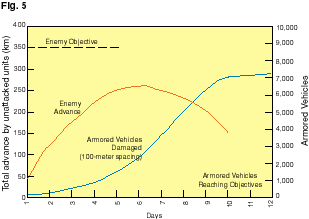 Once every armored unit has been attacked to the damage expectancy goal of at least 70 percent, the enemy’s attack has been, for all intents and purposes, halted. Note that this occurs on Day 10, at which point the rate of kill drops dramatically. US forces may find it difficult to locate undamaged armored vehicles once they halt because the enemy can begin to find or create cover and concealment for his vehicles and because surveillance assets and crews of attacking aircraft are apt to have some difficulty in distinguishing unattacked vehicles from those that have been damaged. At this point, US fixed-wing assets cease expending area munitions and shift to attacks with one-on-one weapons, such as the AGM-86 Maverick missile and laser-guided bombs, which are targeted against individual vehicles.
Once every armored unit has been attacked to the damage expectancy goal of at least 70 percent, the enemy’s attack has been, for all intents and purposes, halted. Note that this occurs on Day 10, at which point the rate of kill drops dramatically. US forces may find it difficult to locate undamaged armored vehicles once they halt because the enemy can begin to find or create cover and concealment for his vehicles and because surveillance assets and crews of attacking aircraft are apt to have some difficulty in distinguishing unattacked vehicles from those that have been damaged. At this point, US fixed-wing assets cease expending area munitions and shift to attacks with one-on-one weapons, such as the AGM-86 Maverick missile and laser-guided bombs, which are targeted against individual vehicles.
Fig. 5 shows our estimate of the number of enemy armored vehicles that reach their objective, defined as being a line 350 km from the prewar border. Obviously, in this case, the estimate is that no vehicles reach this point.
It is worth examining which systems contributed to the successful halt. Fig. 6 shows numbers of armored vehicles damaged by platform type and, at the top of each bar, the average number damaged 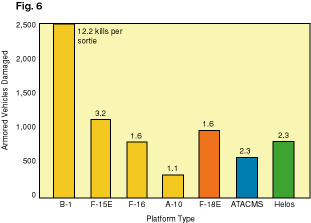 or destroyed per sortie. Perhaps the most striking conclusion that emerges is the potential of large payload aircraft, such as the B-1B, to damage moving armor. With approximately 2,400 kills, the 50 B-1B aircraft deployed in our scenario accounted for more than one-third of the entire joint force’s armor kills during the halt phase. This level of effectiveness results from the B-1B’s large payload and the availability of a highly capable anti-armor weapon that can be delivered from medium altitude. Within the time frame of this analysis, the B-1B is programmed to carry and deliver 30 WCMD/SFWs in a single sortie. This carriage capacity together with the aircraft’s long range, which allows it to be based beyond the strike capabilities of most regional adversaries, makes the modified B-1 a highly attractive asset in the halt phase. By the same token, the F-15E fighter, which can carry at least twice as much ordnance as most other fighterbombers, also plays a disproportionately large role in halting the attack.
or destroyed per sortie. Perhaps the most striking conclusion that emerges is the potential of large payload aircraft, such as the B-1B, to damage moving armor. With approximately 2,400 kills, the 50 B-1B aircraft deployed in our scenario accounted for more than one-third of the entire joint force’s armor kills during the halt phase. This level of effectiveness results from the B-1B’s large payload and the availability of a highly capable anti-armor weapon that can be delivered from medium altitude. Within the time frame of this analysis, the B-1B is programmed to carry and deliver 30 WCMD/SFWs in a single sortie. This carriage capacity together with the aircraft’s long range, which allows it to be based beyond the strike capabilities of most regional adversaries, makes the modified B-1 a highly attractive asset in the halt phase. By the same token, the F-15E fighter, which can carry at least twice as much ordnance as most other fighterbombers, also plays a disproportionately large role in halting the attack.
The ATACMS missile can play an important role as well. If the missiles and their launchers are deployed forward in advance of the conflict and if the advanced BAT munition proves to be effective, this system can be employed in the opening days of the halt campaign even before the enemy’s air defenses have been suppressed. The ATACMS missile thus denies the enemy ground force a free ride even during the portion of the campaign that is most stressful for the defender.
The halt force, in this analysis, expended nearly 9,000 WCMD/SFWs and 2,000 JSOW/SFWs, both filled with Skeet projectiles. It was assumed that most USAF aircraft employed WCMD/SFW while most Navy and Marine aircraft employed JSOW/SFW. However, the currently programmed inventories for these weapons are only around 5,000 WCMD/SFW-Skeets and 3,000 JSOW/SFW-Skeets for the Air Force and fewer than 1,500 JSOW/SFW-Skeets for the Navy and Marines. This programmed stockpile of advanced weapons is probably adequate in scenarios with lengthy periods of buildup because sufficient attack assets would be deployed to permit a brute force approach of destroying armor with large numbers of these and other less-capable munitions. But a robust power projection capability in the face of a determined adversary and a stressing, short-warning scenario would demand munitions that get the most lethality possible out of every sortie.
Variations on the Base Case
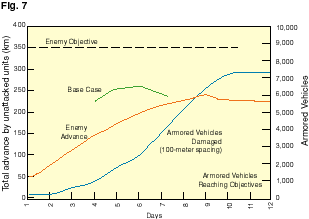 Having presented this base case, we now briefly examine a series of possible alternative cases. Perhaps the most obvious of these is one in which enemy ground forces are able to advance along more than two main axes. We summarize the outcome of such a case in Fig. 7. Here, we assume that enemy ground forces move along seven distinct avenues of advance. However, because some avenues are assumed to have less capacity than the two main axes in our base case, the average movement rate for columns decreases from 70 km per day to 40. We keep constant all of the other variables from the base case.
Having presented this base case, we now briefly examine a series of possible alternative cases. Perhaps the most obvious of these is one in which enemy ground forces are able to advance along more than two main axes. We summarize the outcome of such a case in Fig. 7. Here, we assume that enemy ground forces move along seven distinct avenues of advance. However, because some avenues are assumed to have less capacity than the two main axes in our base case, the average movement rate for columns decreases from 70 km per day to 40. We keep constant all of the other variables from the base case.
Under these conditions, enemy forces are worse off than in the base case: They lose approximately the same number of armored vehicles (around 7,200), but they reach their high-water mark at only 240 km beyond the prewar boundary (vs. 260 in the base case). By moving on more axes, enemy forces can quickly generate more columns that must be neutralized to halt the attack. But this effect is more than offset by the reduced speed of movement, particularly in the early days of the conflict, when US forces are few in number and preoccupied with gaining freedom of action. Given that secondary roads or off-road routes will always have less capacity than major roads, and given the added complexity of coordinating movement of a large mechanized force along multiple axes, some trade-off between the number of axes and average velocity seems inescapable.
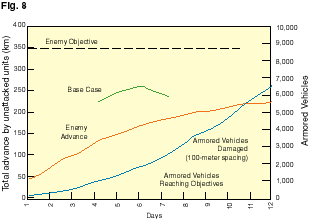 Another obvious counter to area anti-armor weapons, such as Skeet, is to reduce target density. Enemies could spread out their armored vehicles more widely so that each weapon delivered engaged fewer targets. Fig. 8 shows one such case. It is assumed that the average spacing between armored vehicles on the move is 200 meters rather than 100. The number of axes and the average velocity remain the same as in the previous case.
Another obvious counter to area anti-armor weapons, such as Skeet, is to reduce target density. Enemies could spread out their armored vehicles more widely so that each weapon delivered engaged fewer targets. Fig. 8 shows one such case. It is assumed that the average spacing between armored vehicles on the move is 200 meters rather than 100. The number of axes and the average velocity remain the same as in the previous case.
By extending the spacing between vehicles, the enemy has indeed decreased its vulnerability to individual attacks by most of the area weapons. As one would expect, this reduces both the number of armored vehicles damaged and the rate of damage in the opening days of the war. But the enemy has paid a price as well. By opening up the distance between vehicles, it has reduced the number of armored vehicles that can occupy any particular avenue of advance at any one time. The overall transit time for the force is increased. The capability of limited area weapons, such as the Sensor Fuzed Weapon, to maintain a given damage expectancy over a kilometer of enemy column is unaffected. And the halt potential of one-on-one weapons (such as Maverick or Hellfire) or broad area weapons is increased.
The net result is similar to the 100-meter spacing case–a penetration of about 240 km into friendly territory and around 6,700 armored vehicles damaged, with halt imminent on Day 13. This case illustrates an important point: When faced with a mix of US weapons, the opposing commander has no simple options for vehicle spacing. Tighter spacing may improve the speed at which the force can be massed but will dramatically increase the vulnerability of the armor of area weapons like Skeet. Wider spacing both slows the force and actually improves the halt potential of one-on-one weapons. This result highlights the importance of a mix of weapons and joint forces.
Later-arriving firepower assets play a larger role in this case, as the number of armored vehicles damaged in the very early days is reduced. Also noteworthy is that a substantially higher number of air-delivered anti-armor weapons are needed to enforce the halt (17,000 Skeet-dispensing weapons, as opposed to fewer than 11,000 in the base case). Even so, this weapon remains by far the best armor killer for high-payload aircraft such as B-1B and F-15E, but larger quantities of area anti-armor munitions would be needed if greatly increased spacing is regarded as a tactically viable countermeasure by the enemy.
Confronting the WMD Threat
Adversaries would face enormous risks and uncertainties should they use Weapons of Mass Destruction. However, such use cannot be ruled out in the halt phase. How might joint commanders react, and what might the effects be on the halt campaign
First, the threat of WMD use can be expected to affect the ways in which outside forces deploy to the theater. At a minimum, US leaders would want to minimize personnel and assets within range of the most numerous enemy delivery systems. We therefore assume that no fixed-wing, land-based US aircraft are deployed to bases within 500 km of enemy territory. Bases under attack will experience reductions in tempo for some period of time, as operations are interrupted to assess the extent of each attack and as personnel are forced to work in protective suits.
| Fig. 9 Comparative Sortie Rates for Land-Based Forces | ||
| Aircraft | Baseline Sortie Rate | Sortie Rate With WMD |
| B-1B | 0.75 | 0.5 |
| F-15E | 1.67 | 0.9 |
| F-16 | 2.0 | 1.0 |
| A-10 | 2.0 | 1.0 |
| AH-64 | 2.0 | 1.0 |
Fig. 9 provides our assumptions about operations tempo degradation to aircraft that participate in attacks on moving armor in the halt phase. Essentially, we assess the effect if WMD reduced by one-half the sortie rates of all but the longest-range land-based aircraft. We assume that carrier sorties and ATACMS are not affected. Attack helicopters remain forward, but they move frequently to reduce vulnerability to targeting.
Fig. 10 shows the effect of this change on our chief measures of effectiveness: enemy penetration distance and armor kills. Not surprisingly, we see enemy forces penetrating further than in the base case-340 km as opposed to 260-and aircraft destroying 850 fewer vehicles. The main point is that we 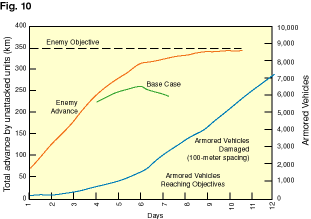 do not see a catastrophic reduction in the effectiveness of US firepower assets in the halt phase, even when the sortie rates of land-based aircraft are substantially reduced. The halt force remains effective, because the most capable attack platforms (B-1Bs and F-15Es) are based beyond the range of most of the enemy’s missiles to begin with; because attack assets are equipped with highly capable munitions; and because each day additional attack capacity is deployed into the theater and brought to bear against the enemy. This approach to power projection, in short, appears to be fairly robust.
do not see a catastrophic reduction in the effectiveness of US firepower assets in the halt phase, even when the sortie rates of land-based aircraft are substantially reduced. The halt force remains effective, because the most capable attack platforms (B-1Bs and F-15Es) are based beyond the range of most of the enemy’s missiles to begin with; because attack assets are equipped with highly capable munitions; and because each day additional attack capacity is deployed into the theater and brought to bear against the enemy. This approach to power projection, in short, appears to be fairly robust.
The analyses summarized above point to our conclusion: Modern, longer-range firepower systems, properly supported with timely information and battle management capabilities and equipped with advanced anti-armor munitions, can effectively engage and heavily damage mechanized forces moving in large numbers. In operational terms, this means that in theaters that do not feature heavily foliated or urbanized terrain, joint US forces can rapidly halt armored invasions even in stressing scenarios, provided that sufficient investments are made in emerging concepts and systems.
Many of the systems most needed to provide robust halt and enable forces are already substantially funded, especially the major platforms, such as the C-17 airlifter and the F-22 fighter. The capabilities most at risk to budget-driven delays generally reside in less-conspicuous programs. These include:
- Advanced munitions, such as smart anti-armor munitions and standoff attack weapons.
- Sensor-to-controller-to-shooter communication links.
- Upgrades to avionics and other systems on existing platforms that will allow them to integrate and employ advanced information and munitions.
- Theater surveillance sensors and platforms, to locate and characterize both enemy maneuver forces and mobile air defenses.
- Pre-positioned assets.
- Improved concepts and capabilities for finding, engaging, and destroying advanced SAM systems, such as the SA-10.
In our rough estimation, additional sustained investments of $2 billion to $2.5 billion per year in these capabilities over a 10-year period should suffice to avoid further debilitating delays and cancellations in these low-profile but critical areas. Fairly modest cuts in later-arriving forces–on the order of 10 to 15 percent–should suffice to generate these funds.
The Carriers in Three CasesOur analysis assumed that carrier operations were not affected by enemy use of WMD. This assumption may or may not be warranted. Three cases shed light on the sensitivity of their results to changes in carrier operations. 1. Delayed Access. We assume that the enemy, using constricting terrain, sophisticated mines, and quiet submarines, delays access of reinforcing maritime forces to the theater for a period of two weeks or so. In this case, the carrier that is in the region at the outset of the conflict continues operations unimpeded, but the second carrier, which arrives on D+7, operates at only half the normal sortie rate because it is constrained to less-favorable operating areas pending success in anti-submarine and mine-sweeping efforts. Our analysis found the effect of the changes on the outcome is minimal relative to the base case. 2. Denial of Access. The carrier on the scene at D-day might be affected by enemy action. We examine a case in which no carrier sorties are available. More enabling forces must be deployed by air early in the conflict, and more time passes before US forces can shift their efforts to heavy attacks on the enemy’s armored formations. In the absence of carrier-based aviation, land-based assets require an additional two days to provide the same number of sorties available in the base case to suppress enemy air defenses and missiles. This need to replace carrier sorties in the enabling portion of the halt phase results in lost sorties for attacking armor for several days. Enemy forces are able to penetrate more deeply than in the base case, almost to their objective. To achieve a result at least as good as the base case, USAF elements would need to be allocated 100 additional tons of daily intertheater airlift capacity-a 12 percent increase. 3. Carriers Only. Carrier-based airpower is especially useful to help speed the enabling portion by striking enemy air defenses and high-leverage fixed targets. This utility, however, is quite distinct from the ability, claimed by some observers, of carriers to serve as a hedge against the possibility that US air forces might not gain access to theater land bases in wartime. We examined a case that eliminated USAF, Marine, and Army air forces in the base case. We replaced it with a truly robust naval force: two battle groups and three arsenal ships (each with 250 ATACMS) on D-day; a third carrier on D+3; and a fourth on D+7. The first two carriers conduct enabling operations that allow all sorties from the others to go to anti-armor attacks. We found that, even if all sorties used high-quality munitions, this armada could not halt a determined invasion: Enemy ground forces start to accumulate at the objective by Day 9. By Day 12, 3,500 armored vehicles are in place at the objective. |
David A. Ochmanek, Edward R. Harshberger, David E. Thaler, and Glenn A. Kent, are analysts with Rand. This article is adapted from a longer research document, To Find, and Not to Yield: How Advances in Information and Firepower Can Transform Theater Warfare, published in late 1998.